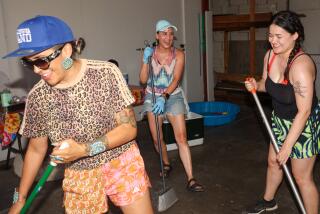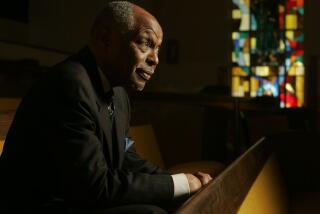Native American Church Bridges Spiritual and Cultural Worlds
The Rev. Marvin Abrams conducts two Communion services, a symbolic act that represents the two worlds of his Native American congregation, two worlds that he has brought together within a single faith.
Abrams, a Seneca born on the Allegany Reservation in western New York, sees no conflict between Christianity and the cultural traditions of Native Americans. The 62-year-old La Mirada resident is pastor of Southern California’s only Native American United Methodist Church, which moved from Norwalk to Anaheim last May.
Abrams maintains a delicate balance between Christian and Native American religious customs, a balance that he believes enlarges the spiritual lives of his congregation. Native American churchgoers should not have to choose between the two, he said.
“We have a Communion service in the church where we do the traditional things,” Abrams said. “And we also go outside to affirm our care for the Earth.
“We return the grape juice back to the Earth and we take the bread and spread it for the creatures of the Earth,” he said. “It’s an act of incorporating the Native American understanding of caring for the Earth--the Earth being our mother, nourishing us, giving us life--and saying that we are going to not only care for each other, but we’re also going to care for the Earth and all the other creatures here. We take responsibility for that.”
It is a challenge, Abrams says, to bring Christian teachings to a people whose ancestors often equated Christianity with those who persecuted them.
“People were telling them, ‘You’ve got to give up all of your cultural traditions,’ ” he said. “In a sense they were saying, ‘Your religion is not as good as ours.’ And what it came to mean was, ‘You’re not as good as we are.’ That’s some of the historical baggage Native Americans are carrying today.”
Abrams became pastor of the congregation in 1978 when services were being held in downtown Los Angeles--20 years after his first church assignment.
The Anaheim church is the congregation’s first permanent home. Dedication ceremonies are still being planned.
The Native American United Methodist Church has 200 ministries throughout the United States serving about 17,000 Native Americans from 51 tribes. Abrams has won recognition from national church leaders for Native American Awareness Sunday, now observed on the second Sunday after Easter.
The Anaheim church, formerly Trinity United Methodist Church, has about 70 Native American members who come from throughout Southern California to attend services. An additional 20 members from Trinity United chose to stay with the church, even though they are not Native American.
“The Trinity church was losing members and they were getting an older congregation,” Abrams said.
“They were not going to have an Easter service because the congregation just felt so dispirited. The district superintendent called me and said, ‘Would you be able to get your folks here for an Easter service?’ which we all hoped would be a symbol of new life and resurrection for the church.”
Inspired by the well-attended Easter service, Trinity church leaders voted in early May to merge with the Native American church. Two weeks later, Native American church leaders also voted for the merger.
“The one stipulation they had is that we would become multicultural. And that was not a problem for us, because we’re multi-tribal.”
Abrams sees himself building bridges between cultures and religions.
Songs in the congregation hymnal represent about 20 different tribal languages. A pipe, traditionally used by Native Americans for prayer ceremonies, is placed on the altar during services.
“This is not just a token representation. We do not incorporate practices unless they have some real connection to the cultural and spiritual life of native people. I’m always cautious about what we try to do in our worship.
“We don’t want to romanticize all of this to the point that we don’t let the Indians out of the 19th century. The Indians that you see on television and in the movies are not the Indians of today.”
More to Read
Sign up for Essential California
The most important California stories and recommendations in your inbox every morning.
You may occasionally receive promotional content from the Los Angeles Times.










